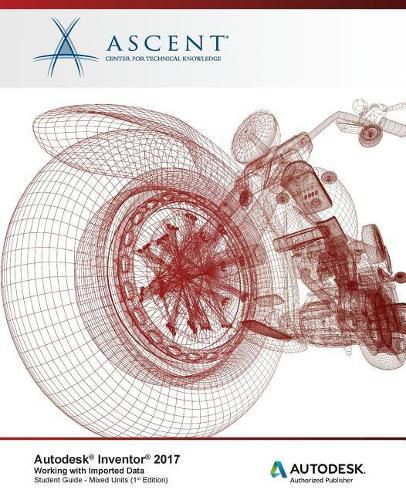Autodesk Inventor 2017 Working with Imported Data: Autodesk Authorized Publisher
Ascent - Center for Technical Knowledge

Autodesk Inventor 2017 Working with Imported Data: Autodesk Authorized Publisher
Ascent - Center for Technical Knowledge
The Autodesk® Inventor® 2017: Working with Imported Geometry student guide teaches you how to work with data from other CAD platforms using the Autodesk Inventor software.
Using this student guide, you will learn the various methods for importing data into Autodesk Inventor and how you can edit both imported solid and surface data. Additionally, you will learn how to index scanned point cloud data, and attach and use it in an Inventor file. The final chapters in this student guide discuss how you can use AutoCAD .DWG files in the Autodesk Inventor software. The topics covered in this student guide are also covered in ASCENT’s Autodesk ® Inventor ® 2017: Advanced Part Modeling student guide, which includes a broader range of advanced learning topics.
Topics Covered
Import CAD data into the Autodesk Inventor software. Export CAD data from the Autodesk Inventor software in an available export format. Index a supported point cloud data file, attach, and edit it for use in a file.
Use the Edit Base Solid environment to edit solids that have been imported into the Autodesk Inventor software. Create Direct Edit features in a model that move, resize, scale, rotate, and delete existing geometry in both imported and native Autodesk Inventor files. Set the import options to import surface data from other file format types. Transfer imported surface data into the Repair Environment to conduct a quality check for errors. Appropriately set the stitch tolerance value so that gaps in the imported geometry can be automatically stitched and identify the gaps that are not stitched. Use the Repair Environment commands to repair gaps or delete, extend, replace, trim and break surfaces to successfully create a solid from the imported geometry. Open an AutoCAD DWG file directly into an Autodesk Inventor part file and review the data. Use the DWG/DXF File Wizard and its options to import files into an Autodesk Inventor file. Use an AutoCAD DWG file in an Autodesk Inventor part file so that the geometry created in Inventor remains associative with the AutoCAD DWG file. Freeform modeling. Emboss and Decal features. Advanced Drawing tools (iPart tables, surfaces in drawing views, and custom sketched symbols). Adding notes with the Engineer’s Notebook.
Prerequisites The material covered in this student guide assumes a mastery of Autodesk® Inventor® basics as taught in the Autodesk® Inventor® Introduction to Solid Modeling student guide.
This item is not currently in-stock. It can be ordered online and is expected to ship in approx 2 weeks
Our stock data is updated periodically, and availability may change throughout the day for in-demand items. Please call the relevant shop for the most current stock information. Prices are subject to change without notice.
Sign in or become a Readings Member to add this title to a wishlist.


